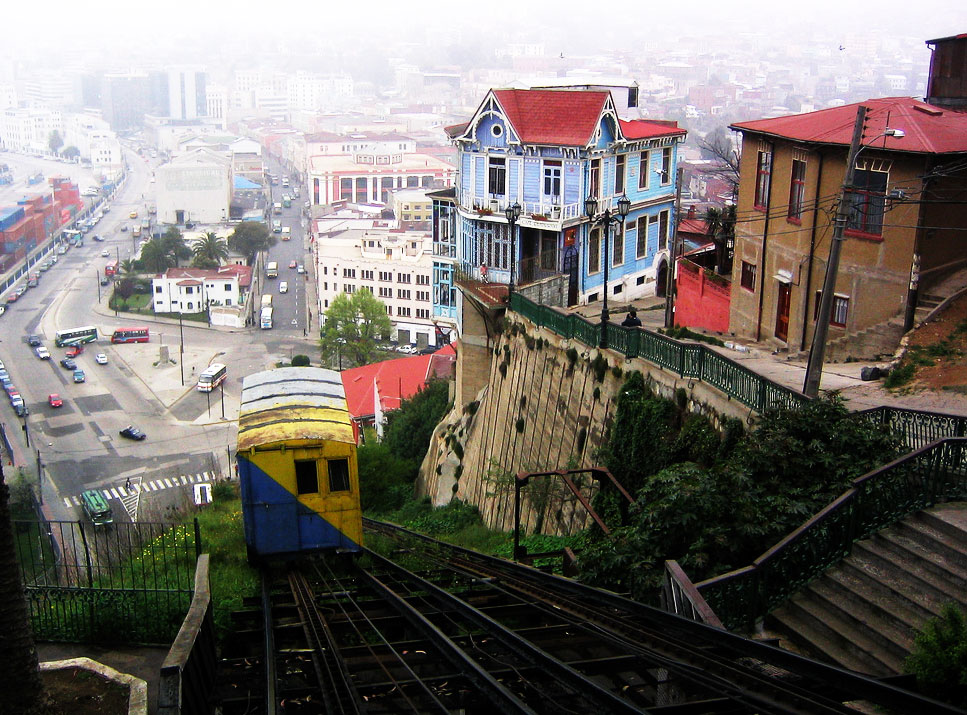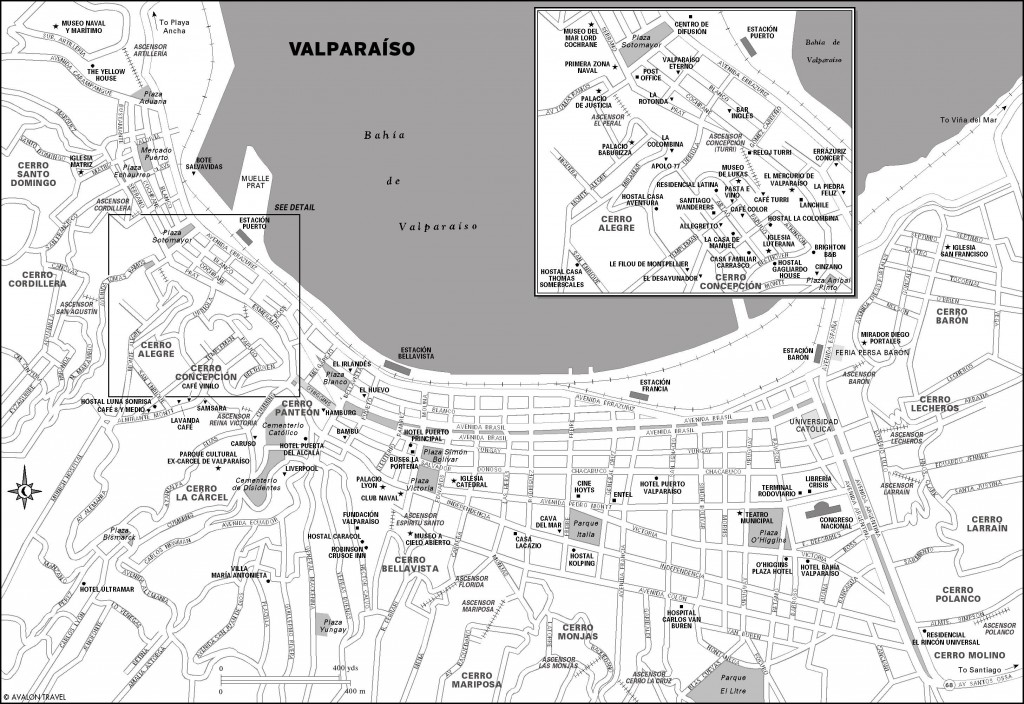
Dating from 1894, Ascensor Artillería extends for 175 meters with a 30-degree gradient. Photo © Phil Whitehouse, licensed Creative Commons Attribution.
Like San Francisco, Chile’s main seaport owes its growth to the California gold rush, when it was a strategic stopover on the passage around the Horn. Also like San Francisco, it has so many hills that a walking tour of its streets, steps, and winding footpaths can be a productive cardiovascular workout. For those who tire of walking, several funiculars—comparable to San Francisco’s cable cars—lift Porteños (as city residents are known) from the downtown financial and commercial districts to their hillside neighborhoods. East and south of Valparaíso are several excursion options, including Casablanca Valley wineries and Pablo Neruda’s Isla Negra beachfront home. Declared a UNESCO World Heritage Site for its unique urban geography, Valparaíso is undergoing a real-estate renaissance as the values of its distinctive traditional houses—Victorian-style structures clad with calamina (corrugated metal)—rise as steeply as the hills themselves. Trash collection has improved with the placement of dumpsters at key locations, but, unfortunately, this has driven street dogs into other neighborhoods where residents still leave wet garbage in plastic bags. The streets, alleyways, sidewalks, and staircases are still dappled with canine soretes—watch your step or wash your feet.Valparaíso’s rundown port, its least attractive area despite two kilometers of prime ocean frontage, is undergoing an overdue privatization and modernization of its docks to improve their handling capacity and tourist appeal. In addition, construction of a new southern access route has reduced heavy truck traffic through downtown’s congested core and is opening the waterfront to the public.
East and south of Valparaíso are several excursion options, including Casablanca Valley wineries and Pablo Neruda’s Isla Negra beachfront home. There is no direct road south from Valparaíso, but the paved road west/southwest from the Casablanca Valley passes through a series of popular beachfront towns. Regular bus service from Valparaíso is with Pullman Bus Lago Peñuelas, and from Santiago with several companies.

Valparaíso
European Valparaíso dates from the winter of 1536, when Juan de Saavedra, who had split off from Diego de Almagro’s expedition and reached the coast at Concón, miraculously met Almagro’s supply ship El Santiaguillo at the indigenous settlement of Quintil, the site of present-day Plaza Echaurren. Despite selection by Pedro de Valdivia as Santiago’s port, it suffered from Madrid’s mercantile policy, which restricted direct commerce with any other Spanish South American port except Lima. This, of course, encouraged both contraband, which couldn’t compensate for lack of an orderly trade, and piracy, which damaged the economy.
Madrid finally granted a cabildo (town council) in 1791 and formal recognition as a city in 1802, but by then the irregular terrain and spontaneous growth had defeated the Spanish ideal of a quadrangular city plan. Despite its port status, the first pier was not finished until 1810, the year of Chile’s independence.
War with Spain continued into the 1820s, but Valparaíso soon became a vibrant immigrant city of North Americans, British, Germans, Italians, Yugoslavs, and other ethnic communities. English writer Maria Graham, who spent several months in Valparaíso as the war with Spain raged into the 1820s, described its bustling commerce:
The English shops are more numerous than any. Hardware, pottery, and cotton and woolen cloths form of course the staple articles…. The Germans furnish most of the glass in common use. It is of bad quality to be sure, but it, as well as the little German mirrors, which are chiefly brought to hang up as votive offerings in the chapels, answers all the purposes of Chileno consumption…. English tailors, shoemakers, saddlers, and inn-keepers hang out their signs in every street, and the preponderance of the English language… would make one fancy Valparaíso a coast town in Britain.
Valparaíso remained provincial for some years—Graham remarked that the Iglesia Matriz (predecessor of today’s namesake church) “like all other buildings here, appears mean from without.” It boomed after the mid- 19th century, though, as the main port for commercial vessels rounding Cape Horn, with wheat exports to gold-mad California, completion of the railroad to Santiago in 1863, and rapid advances in banking.
Thanks to its immigrants, Valparaíso became Chile’s most cosmopolitan city and a leader in modern infrastructure such as tramways, electricity, and gas. Like San Francisco, the Americas’ other cosmopolitan Pacific port, Valparaíso suffered a crippling 1906 earthquake. The opening of the Panama Canal was even more devastating—it became a terminal rather than an intermediate port, as European shipping could avoid the long and dangerous route around the Horn. The collapse of nitrate exports, thanks to synthetic substitutes, followed by the Great Depression of the 1930s, nearly paralyzed the economy until after World War II, when copper exports recovered. Even with the economy’s post-1970s recovery, Valparaíso has lost its primary port status to San Antonio, southeast of and closer to Santiago, over easier terrain. It has, however, gained political influence with the transfer of the Congress under the custom constitution of Pinochet (a Valparaíso native) despite strong sentiments, and many practical reasons, for moving it back to Santiago.
Traditionally, Valparaíso has played second fiddle to nearby Viña del Mar in the tourist trade, but its World Heritage Site status has spawned interest in the city. With the opening of ever more tourist hotels, B&Bs, and restaurants, it’s become a viable alternative to Viña.
Excerpted from the Fourth Edition of Moon Chile.